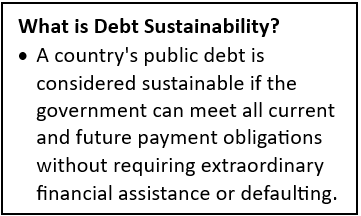- Courses
- GS Full Course 1 Year
- GS Full Course 2 Year
- GS Full Course 3 Year
- GS Full Course Till Selection
- MEP (Mains Enrichment Programme) Data, Facts
- Essay Target – 150+ Marks
- Online Program
- GS Recorded Course
- NCERT- First Ladder
- Polity
- Geography
- Economy
- Ancient, Medieval and Art & Culture AMAC
- Modern India, Post Independence & World History
- Environment
- Governance
- Science & Technology
- International Relations and Internal Security
- Disaster Management
- Ethics
- Current Affairs
- Indian Society and Social Issue
- CSAT
- 5 LAYERED ARJUNA Mentorship
- Public Administration Optional
- ABOUT US
- OUR TOPPERS
- TEST SERIES
- FREE STUDY MATERIAL
- VIDEOS
- CONTACT US
Global Debt
Global Debt
20-12-2023
Context
- Sri Lanka's unsustainable debt and severe balance of payments crisis highlight the broader issue of increasing debt in developing countries.
About Global Debt
- Global debt encompasses borrowings by governments, private businesses, and individuals worldwide.
- Governments borrow to cover various expenditures not met by taxes and revenues. This may include paying interest on past borrowings. Private entities primarily borrow for making investments.
Growing Debt Trends
- Developing nations often accumulate debt for large-scale infrastructure projects, promoting economic growth.
- A recent United Nations report reveals that global public debt surged to an all-time high of $92 trillion in 2022 from $17 trillion in 2000.
Reasons Behind Growing Debt
- Higher Costs: Developing countries face significantly higher interest rates than developed ones.

- Resource Allocation: Half of these nations allocate over 1.5% of GDP and 6.9% of government revenues to interest payments.
- Shift to Private Creditors: Increasing reliance on market-driven borrowings from private creditors, diverging from traditional reliance on multilateral institutions.
- Debt Restructuring Challenges: External creditors avoid restructuring debt for countries in crisis.
- Internal Factors: Poor debt management, inefficient tax policies, and legal weaknesses contribute to the problem.
Concerns Raised Due to High Debt Burden
- Debt Sustainability: High debt burdens force countries to borrow from more expensive sources, exacerbating vulnerabilities and complicating debt crisis resolution.
- Example: Sri Lanka losing international financial market access in 2022 due to unsustainable public debt.
- Impact on Developmental Spending: Countries spending more on interest than health or education affects developmental priorities for 3.3 billion people.
- Hindrance to Sustainable Development: Over 70% of public climate finance is in the form of debt, limiting spending on climate initiatives in debt-ridden countries.
- Political and Social Turmoil: Economic struggles blamed on governments lead to political instability.
- Global Financial Stability: High debt levels in developing countries contribute to global financial instability.
Way Forward
-
 Inclusive Financial Governance: Enhance the genuine involvement of developing countries in international financial governance.
Inclusive Financial Governance: Enhance the genuine involvement of developing countries in international financial governance.- Implement reforms, such as updating IMF quota formulas, to reflect the evolving global scenario.
- Ensuring Liquidity in Crisis: Provide increased liquidity during crises through IMF and MDBs to discourage unsustainable high-interest financing by developing nations.
- Transparent Debt Reporting: Mandate comprehensive and transparent reporting of public debts by all countries.
- Greater transparency helps prevent the accumulation of significant "hidden" liabilities, which may later transform into explicit government debt.
- Prudent Debt Management: Encourage low-income countries to adopt cautious approaches in acquiring new debt.
- Focus on attracting foreign direct investment and boosting tax revenues instead of heavily relying on loans.
- Lenders should assess the impact of new loans on the borrower's debt position before extending fresh credit.
- Promoting Debt Restructuring Collaboration: Foster collaboration among official creditors to prepare for debt restructuring cases, especially those involving non-traditional lenders.
- Fulfilling Climate Finance Commitments: Provide credit for climate mitigation to address one of the leading causes of high public debt.

Conclusion
- Balanced Approach: Maintaining a balanced approach to global debt management is crucial for economic stability and sustainable growth.
- Key Measures: Monitoring debt levels, implementing prudent fiscal and monetary policies, and strengthening international financial systems are vital steps in mitigating risks associated with growing global debt.
- Long-Term Prosperity: Striking the right balance between debt accumulation and economic growth remains essential for long-term economic prosperity.



